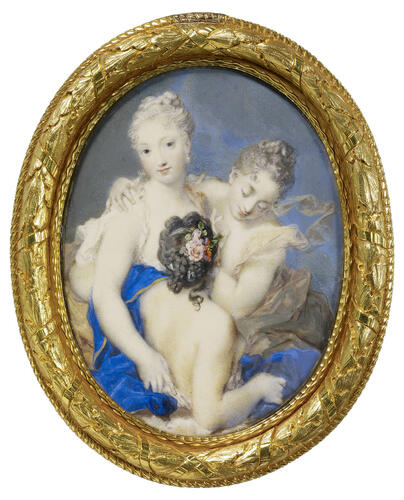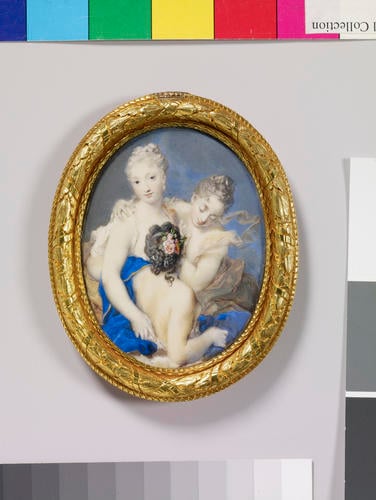-
1 of 253523 objects
Françoise-Marie, Duchesse d'Orléans (1677-1749), as Amphitrite 1697 - 1757
Watercolour on ivory | 8.5 x 6.5 cm (sight) (sight) | RCIN 420360

Rosalba Giovanna Carriera (Venice 1673-Venice 1757)
Françoise-Marie, Duchesse d'Orléans (1677-1749), as Amphitrite 1697 - 1757

Rosalba Giovanna Carriera (Venice 1673-Venice 1757)
Françoise-Marie, Duchesse d'Orléans (1677-1749), as Amphitrite 1697 - 1757


-
Françoise-Marie was the daughter of Louis XIV of France. In 1692, she married Philippe d'Orléans who, on the death of the King in 1715, became Regent of France for eight years.
This group has been adapted by Rosalba Carriera (1675-1757) from an allegorical painting at Versailles, France, by a follower of Pierre Mignard. It depicted Louis XIV's daughter as Amphritrite, a sea-goddess, seated on a dolphin surrounded by nereids or sea nymphs, with Poseidon, her husband, in the background. Rosalba presumably saw the painting on her visit to Paris in 1720-1.
Rosalba trained in Venice as a pastel artist and miniaturist. She travelled to Paris and Vienna, but it was visitors to Venice on the 'Grand Tour' who provided her main source of business. She pioneered the use of ivory – a difficult, non-absorbent material – as a support for miniatures. She never visited England although her influence can be seen in the work of English artists such as Bernard Lens, and George III acquired a number of her pastels for the Royal Collection. She became blind in 1749.
Inscribed on the back in nineteenth-century handwriting in pencil: Louise Henrietta / d. of Louis Philippe D. of Orléans / Father of Egalité.Provenance
Possibly a present from Louis-Philippe to Queen Victoira in 1843 or 1844; first recorded in the Royal Collection in 1870
-
Medium and techniques
Watercolour on ivory
Measurements
8.5 x 6.5 cm (sight) (sight)
11.0 x 9.0 cm (frame, external)
Other number(s)
RL 1870 37.B.3Alternative title(s)
Françoise-Marie, Duchess of Orléans (1677-1749), as Amphitrite
Louise-Henrietta de Conti (1726-1759), Duchesse d'Orléans, previously identified as